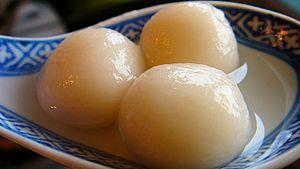
Image via Wikipedia
Do you find it interesting to learn Chinese language? If you do, you might want to start somewhere. Most beginners really had a hard time coping up how to start their Chinese language learning. If you haven’t decided it yet, perhaps this option makes a good start for you: Learning common Chinese terminologies in cooking.
Almost all of us are familiar with Chinese cuisine; some find it extremely delicious. We are all familiar with seafood noodles and sushi, but how about the other terms? This is then where we are going to detail the following common terms to make Chinese learning easier.
Chinese cooking term
Pin Yin Pronunciation
English meaning
煮 Zhu Cook/boil.
煎 Jian Pan-fry or shallow fry.
炒 Chao Stir-fry.
蒸 Zheng Steam.
炸 Zha Deep fry.
拌/撈 BanLao (Cantonese) The technique of mixing sauces and oil into cooked noodle as seasoning, for example dry wonton noodle. Noodle is first boiled in boiling water, drained and placed onto a plate where cooked oil and soya sauce are added, then tossed and mixed well into the noodle. Can also mean tossing salad in its dressing, or adding sauce to rice.
灼 Zhuo A very basic technique especially in Cantonese cooking, where food (such as whole chicken or prawns) is simply cooked in boiling water or soup then drained and served. Works best with fresh meat, not frozen.
滷 Lu Cooking food (particularly meat and eggs) in a stock made from various spices, ginger, sugar, dark soya sauce and light soya sauce, etc, on low heat for a few hours till the dark coloured stock is heavily absorbed into the meat or egg. The stock can usually be cooked and kept for a long time, and be used over and over again; because it’s believed that the aroma and taste get better over time.
熗 Qiang Generally used in preparing vegetables, where vegetables are lightly cooked in hot water or oil, drained then topped with sauce mix such as oyster sauce and fragrant oils. Usually treated as a snack or side dish.
腌 Yan To marinate with salt or other seasonings.
爆 Bao A quick frying method, using less oil than deep-frying, to get food in crispy texture and not over cooked. For example the ‘browning’ of meats and crispy onions.
涮 Shua Fondue, or “steamboat” in some Asian countries, where food is thinly sliced and cooked by dipping it into boiling soup, and to be eaten on the spot.
燜 Men A stewing or braising process, in which case the ingredients are fried with oil, then transferred into another pot (usually a clay pot) to be cooked on low heat, with the lid on.
煨 Wei Stew. This technique is very close to the English stewing technique, but without using an oven.
燻 Xun Smoke, by placing food on a stand in the pot over the stove, with smoking ingredients such as spices or tealeaves underneath the stand.
燴 Hui Also referred to as “braise”, but with starchy gravy.
溜 Liu Stir-fry with starchy gravy.
Aren’t’ these Chinese glossaries helpful to your Chinese language learning? You can learn more when you go to foreign language schools, you know. These are actually few out of the many terms a learner will encounter during the process. But, who knows, right? A simple step of learning, once began and continued, turns out to be a larger step of higher learning already. Everything starts from one lesson at a time, and from this, you might want to make a quick and easy start.

